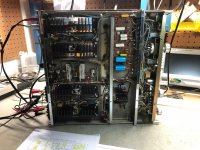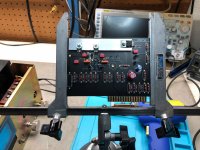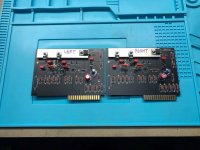Hi, This is XrayTonyB from YouTube. I know that's not my diyAudio user name (it's a long story). I'm starting this thread for those who are planning on using the MC2100 driver boards I featured on my YouTube channel ( youtube.com/xraytonyb ). The link to one of the videos from the series is below:
YouTube
Although I've been a member for several years, this is my first thread, so bear with me as I learn the ropes! Thanks!
YouTube
Although I've been a member for several years, this is my first thread, so bear with me as I learn the ropes! Thanks!
 Welcome to posting on the forum. If this is a commercial product that you sell, it should be in the Vendor's section.
Welcome to posting on the forum. If this is a commercial product that you sell, it should be in the Vendor's section.Hi Tony, Looks like I am the first to post to this thread1 Yea me! *8^D
What was the name of that non-conductive epoxy you used to mount the double diodes on the heat sink?
What was the name of that non-conductive epoxy you used to mount the double diodes on the heat sink?
Hey Tony, thanks for all the videos and tech info. Your Push Pull DIY was great, I’m looking to use a matching quad of 807’s I have and now I may have changed my mind. Any chance on getting a hold of finished schematics look over?
Hi Tony, Looks like I am the first to post to this thread1 Yea me! *8^D
What was the name of that non-conductive epoxy you used to mount the double diodes on the heat sink?
I actually purchased the adhesive through eBay a long time ago. I think it was factory surplus out of china, as all of the writing on the tube was in Chinese. Just search for "Thermal Adhesive" and you should be able to find it. I think it's pretty common. You can also use JB Weld two-part epoxy. I've had very good success with it as well.
HI lego4040. I want to try and keep this thread focused on the experimental MC2100 driver project. If you go back to the video to which you are referring, I have an e-mail address where you can e-mail me about it. Thanks!
Thanks Tony, I found some thermal epoxy at Newark. By the way, I got the boards last Thursday.I actually purchased the adhesive through eBay a long time ago. I think it was factory surplus out of china, as all of the writing on the tube was in Chinese. Just search for "Thermal Adhesive" and you should be able to find it. I think it's pretty common. You can also use JB Weld two-part epoxy. I've had very good success with it as well.
I'm starting the rebuild of my MC2105. This unit was making an interesting high pitched noise without having speakers attached. In your videos on the MC2100 you mentioned the propensity of this amp series to go into oscillation. In checking the output transformers, I found one that had an hFE value of 126 which seems very high. I believe this appears to be the one that is making the noise. Would the high hFE value cause this transistor to oscillate?
At any rate, I've decided to replace all the output transistors with the MJ21194G.
Hey Tony, your two videos about the new output boards were linked on the following audiokarma forum MC2100 To Do's | Page 6 | Audiokarma Home Audio Stereo Discussion Forums and comments were made. You might want to check that out.
I'm still gathering parts for my MC2105 rebuild and will post on the progress when I have made some.
Karl
I'm still gathering parts for my MC2105 rebuild and will post on the progress when I have made some.
Karl
MC2100/2105 Tony B. Boards finished!
Hey there to anyone who is watching this thread! I finished both the right and left output boards for my McIntosh MC2105. These are the experimental boards that Tony produced earlier this year. See the attached photo for the finished products.
I simply followed Tony's very clear and informative videos and did everything exactly as prescribed with one exception. I did not opt to add the external biasing diodes but instead utilized all three of the suggested diodes on the board.
I also rebuilt the entire power section along with all of the filter caps and all the output transistors. I used the MJ21194 transistors and replaced all the 0.33 and 0.56 5W power output resistors as well.
This all worked the first time I tried it on the Dim Bulb tester much to my delight!
I tested the unit at several frequencies including down to 20 Hz and as high as 50KHz. THD was solid around 0.09 or less.
Something to note is that even though the McIntosh MC2300 (yes that's 300W/channel) has the exact same original output boards, Tony's experimental boards will not fit.
This is due to a difference in the McIntosh amplifier chassis design. The output boards for the 2100/2105 chassis are mounted parallel on either side of the large filter caps. On the 2300 chassis which is necessarily much larger and has 4 of the large filter caps, the boards are mounted in series.
Tony designed the experimental boards slightly larger than the originals which is no problem with either the 2100 or the 2105. However, they are too long to fit into both mounting slots in the 2300 design.
Unfortunately for me that leaves me with an extra set of Tony's experimental boards. But that's OK, maybe I will get another 2105 some day!
Anyway, I had a great time doing this project and look forward to more of Tony's excellent videos. Maybe one of the other fine McIntosh products like the C32 pre-amp will come his way.
Good luck everyone.
Hey there to anyone who is watching this thread! I finished both the right and left output boards for my McIntosh MC2105. These are the experimental boards that Tony produced earlier this year. See the attached photo for the finished products.
I simply followed Tony's very clear and informative videos and did everything exactly as prescribed with one exception. I did not opt to add the external biasing diodes but instead utilized all three of the suggested diodes on the board.
I also rebuilt the entire power section along with all of the filter caps and all the output transistors. I used the MJ21194 transistors and replaced all the 0.33 and 0.56 5W power output resistors as well.
This all worked the first time I tried it on the Dim Bulb tester much to my delight!
I tested the unit at several frequencies including down to 20 Hz and as high as 50KHz. THD was solid around 0.09 or less.
Something to note is that even though the McIntosh MC2300 (yes that's 300W/channel) has the exact same original output boards, Tony's experimental boards will not fit.
This is due to a difference in the McIntosh amplifier chassis design. The output boards for the 2100/2105 chassis are mounted parallel on either side of the large filter caps. On the 2300 chassis which is necessarily much larger and has 4 of the large filter caps, the boards are mounted in series.
Tony designed the experimental boards slightly larger than the originals which is no problem with either the 2100 or the 2105. However, they are too long to fit into both mounting slots in the 2300 design.
Unfortunately for me that leaves me with an extra set of Tony's experimental boards. But that's OK, maybe I will get another 2105 some day!
Anyway, I had a great time doing this project and look forward to more of Tony's excellent videos. Maybe one of the other fine McIntosh products like the C32 pre-amp will come his way.
Good luck everyone.
Attachments
Hi Tony, I have had a chance to run this amp for a while now and I can report that while it is very steady and sounds great, the output transistors seem to be running quite warm. I have the amp installed in the original wood case and it has triggered the heat cutoff several times now.
I used the MJ21194 transistors that I believe you also used and it seems from the videos that you did not experience this problem. Is there something else I need to look at with regard to the additional heat build up? This amp has always been in this particular original wood cabinet so nothing has changed externally.
The heat shutoff system is there to protect the output transistors against run away current such as you'd have with a shorted speaker etc. None of that is happening here.
Anyway, any thoughts on this?
Thanks again,
Karl Oberlander
I used the MJ21194 transistors that I believe you also used and it seems from the videos that you did not experience this problem. Is there something else I need to look at with regard to the additional heat build up? This amp has always been in this particular original wood cabinet so nothing has changed externally.
The heat shutoff system is there to protect the output transistors against run away current such as you'd have with a shorted speaker etc. None of that is happening here.
Anyway, any thoughts on this?
Thanks again,
Karl Oberlander
- Home
- Amplifiers
- Solid State
- McIntosh MC2100 Driver Boards By XrayTonyB


